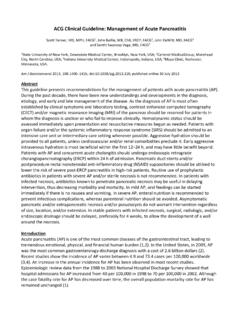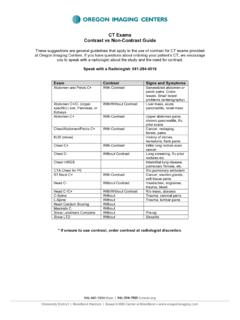Transcription of Diagnosis and Management of Acute Diverticulitis
1 612 American Family Physician Volume 87, Number 9 May 1, 2013 Uncomplicated Diverticulitis is localized diverticular inflammation, whereas complicated Diverticulitis is diverticular inflammation associated with an abscess, phlegmon, fistula, obstruction, bleeding, or perforation. Patients with Acute Diverticulitis may present with left lower quadrant pain, tenderness, abdominal distention, and fever. Other symp-toms may include anorexia, constipation, nausea, diarrhea, and dysuria. Initial laboratory studies include a complete blood count, basic metabolic panel, urinalysis, and measurement of C-reactive protein.
2 Computed tomography, the most commonly performed imaging test, is useful to establish the Diagnosis and the extent and severity of disease, and to exclude complications in selected patients. Colonoscopy is recommended four to six weeks after resolution of symptoms for patients with complicated disease or for another indication, such as age-appropriate screening. In mild, uncomplicated Diverticulitis , antibiotics do not accelerate recovery, or prevent complications or recurrences. Hospi-talization should be considered if patients have signs of peritonitis or there is suspicion of complicated Diverticulitis . Inpatient Management includes intravenous fluid resuscitation and intravenous antibiotics.
3 Patients with a localized abscess may be candidates for computed tomography guided percutaneous drainage. Fifteen to 30 percent of patients admitted with Acute Diverticulitis require surgical intervention during that admission. Laparoscopic surgery results in a shorter length of stay, fewer complications, and lower in-hospital mortality compared with open colectomy. The decision to proceed to surgery in patients with recurrent Diverticulitis should be individualized and based on patient preference, comorbidities, and lifestyle. Interventions to prevent recurrences of Diverticulitis include increased intake of dietary fiber, exercise, cessation of smoking, and, in persons with a body mass index of 30 kg per m2 or higher, weight loss.
4 (Am Fam Physician. 2013;87(9):612-620. Copyright 2013 American Academy of Family Physicians.) Diagnosis and Management of Acute DiverticulitisTHAD WILKINS, MD; KATHERINE EMBRY, MD; and RUTH GEORGE, MD, Georgia Regents University, Augusta, Georgiacute Diverticulitis is inflammation of the colonic diverticulum, which may involve perforation or micro-perforation (Figures 1 and 2). In Western societies, most diverticula (85 percent) are found in the sigmoid and descending colons; diverticula in the ascending colon are more common in Asian Uncomplicated Diverticulitis is localized inflammation, and complicated Diverticulitis is inflammation associated with an abscess, phlegmon, fistula, obstruc-tion, bleeding, or This article reviews Acute Diverticulitis in adults and excludes special populations, such as chil-dren and pregnant , defined as the presence of diverticula in the absence of inflamma-tion.
5 Occurs in 5 to 10 percent of persons older than 45 years and approximately 80 percent of those older than 85 In 1998, there were million cases of Acute Diverticulitis in the United States, result-ing in $ billion in health care expen-ditures and approximately 3,400 From 1998 to 2005, the annual age-adjusted admissions for Diverticulitis increased by 26 percent, with the greatest increased rates of admissions occurring in persons 18 to 44 years of age (82 percent) and 45 to 74 years of age (36 percent).4 In the United States, there is an increased incidence of admis-sions for Acute Diverticulitis in the sum-mer months compared with other months, regardless of age, sex, race, or geographic Of those who have diverticulosis, the lifetime prevalence of developing Acute Diverticulitis is approximately 25 and Risk FactorsFactors associated with diverticulosis include alterations in colonic wall resistance, colonic motility, and dietary issues, such as lack of fiber.
6 That contribute to increased intralu-minal pressure and weakness of the bowel Genetic susceptibility is an important Patient information: A handout on this topic, written by the authors of this article, is avail-able at Access to the handout is free and unrestricted. ADownloaded from the American Family Physician website at Copyright 2013 American Academy of Family Physicians. For the private, non-commercial use of one individual user of the website. All other rights reserved. Contact for copyright questions and/or permission DiverticulitisMay 1, 2013 Volume 87, Number 9 American Family Physician 613component for the development of diverticular disease because monozygotic twins are twice as likely as dizy-gotic twins to develop Aspirin and non-steroidal anti-inflammatory drugs increase the risk of Diverticulitis (hazard ratio = to ).
7 8 Other risk fac-tors for Diverticulitis include increasing age, obesity, and lack of Symptom severity, signs of peritonitis, and the patient s ability to tolerate oral intake guide diagnostic testing and clinical Management . The differential Diagnosis includes mechanical and inflammatory disorders of the gastrointestinal tract, urologic and gyneco-logic disorders, functional disorders, and malignancy (Ta b l e 1).HISTORY AND PHYSICAL EXAMINATIONP atients often present with Acute , constant abdominal pain that is usually in the left lower ,9 Other possible symptoms include anorexia, constipation, nausea, diarrhea, and Patients may have a history of diverticulosis or diverticuli-tis.
8 Although patients with Diverticulitis typically have a fever (usually below 102 F [39 C]), in one study, nine of 62 patients with Acute Diverticulitis were Tachycardia and hypotension may occur and should raise suspicion for complicated Diverticulitis . On examination, tenderness only in the left lower quadrant significantly increases the likelihood of Acute diverticu-litis (positive likelihood ratio = ), as do a palpable mass and abdominal Rebound tenderness, rigidity, and the absence of peristalsis are not accurate for Diagnosis of Acute Diverticulitis , but may suggest peritonitis (positive likelihood ratio = ; negative likelihood ratio = ).
9 11 A rectal examination may reveal tender-ness or a mass if a low-lying pelvic abscess is Ta b l e 2 provides a summary of the accuracy of signs, symptoms, and laboratory tests for Diagnosis of Acute ,12-14 Figure 3 provides an algorithmic approach to patients with suspected Acute STUDIESB ecause leukocytosis is present in 55 percent of patients with Acute Diverticulitis , a com-plete blood count should be Blood should be collected for a basic metabolic panel to assess electro-lytes and renal function. A urinalysis is useful for rul-ing out urinary tract infection, and a human chorionic gonadotropin urine test should be considered in pre-menopausal women to exclude pregnancy, particularly if antibiotics, imaging, or surgery is being considered.
10 During the rectal examination, stool should be obtained for a fecal occult blood test to exclude occult gastroin-testinal of C-reactive protein (CRP) should be considered. When the patient has left lower quad-rant tenderness and a CRP level greater than 50 mg Figure 1. Colonoscopic image demonstrating peridiverticular inflam-mation (thin arrow) and showing multiple blood clots within diver-ticula (thick arrows).Figure 2. (A) Diverticulosis is the presence of diverticula in the absence of inflammation. (B) Diverticulitis is inflammation of a BY RENEE CANNON Acute Diverticulitis614 American Family Physician Volume 87, Number 9 May 1, 2013per L ( nmol per L) in the absence of vomit-ing, the likelihood of Acute Diverticulitis is signifi-cantly increased (positive likelihood ratio = 18).













